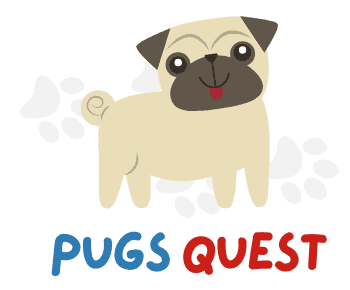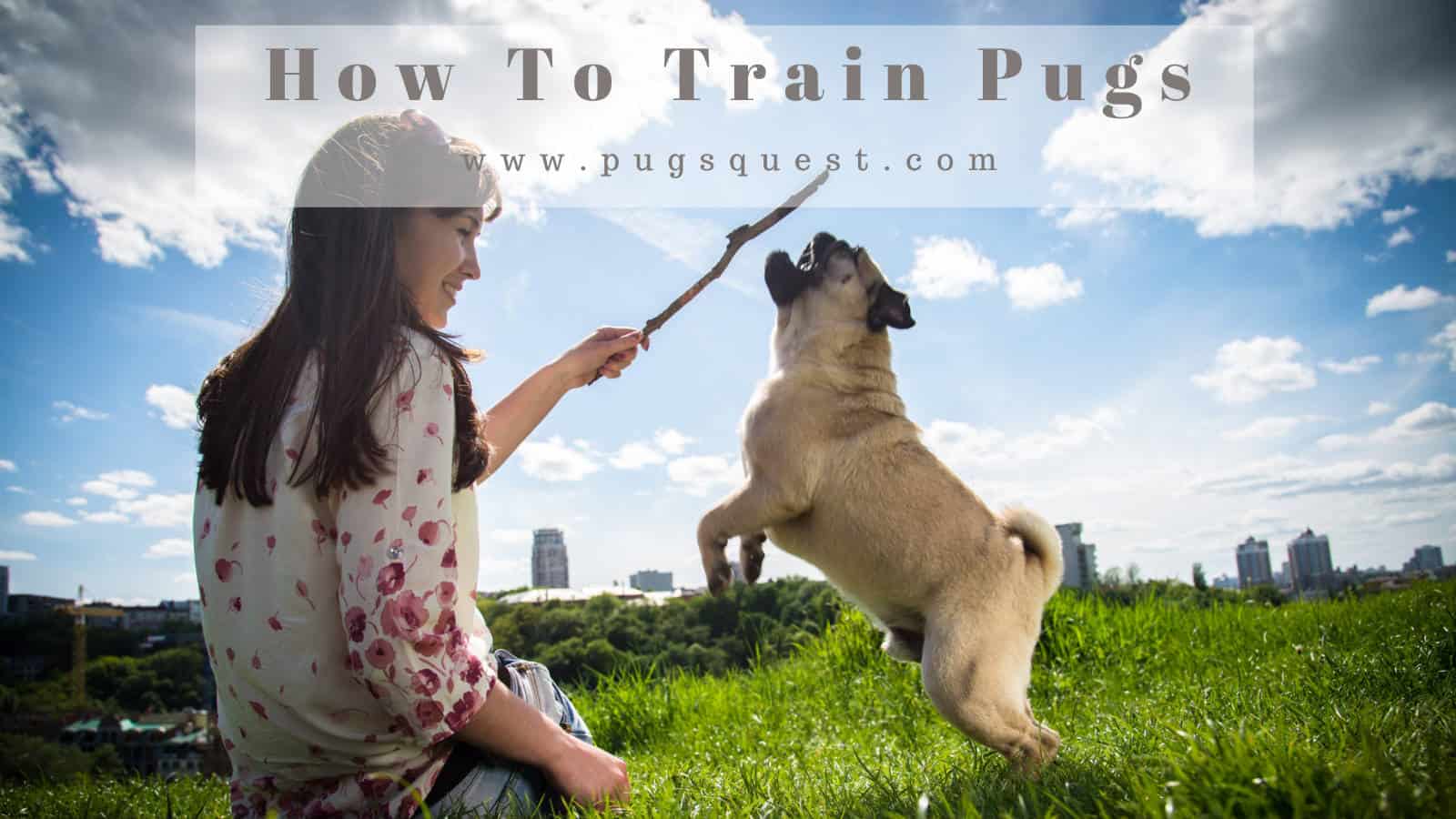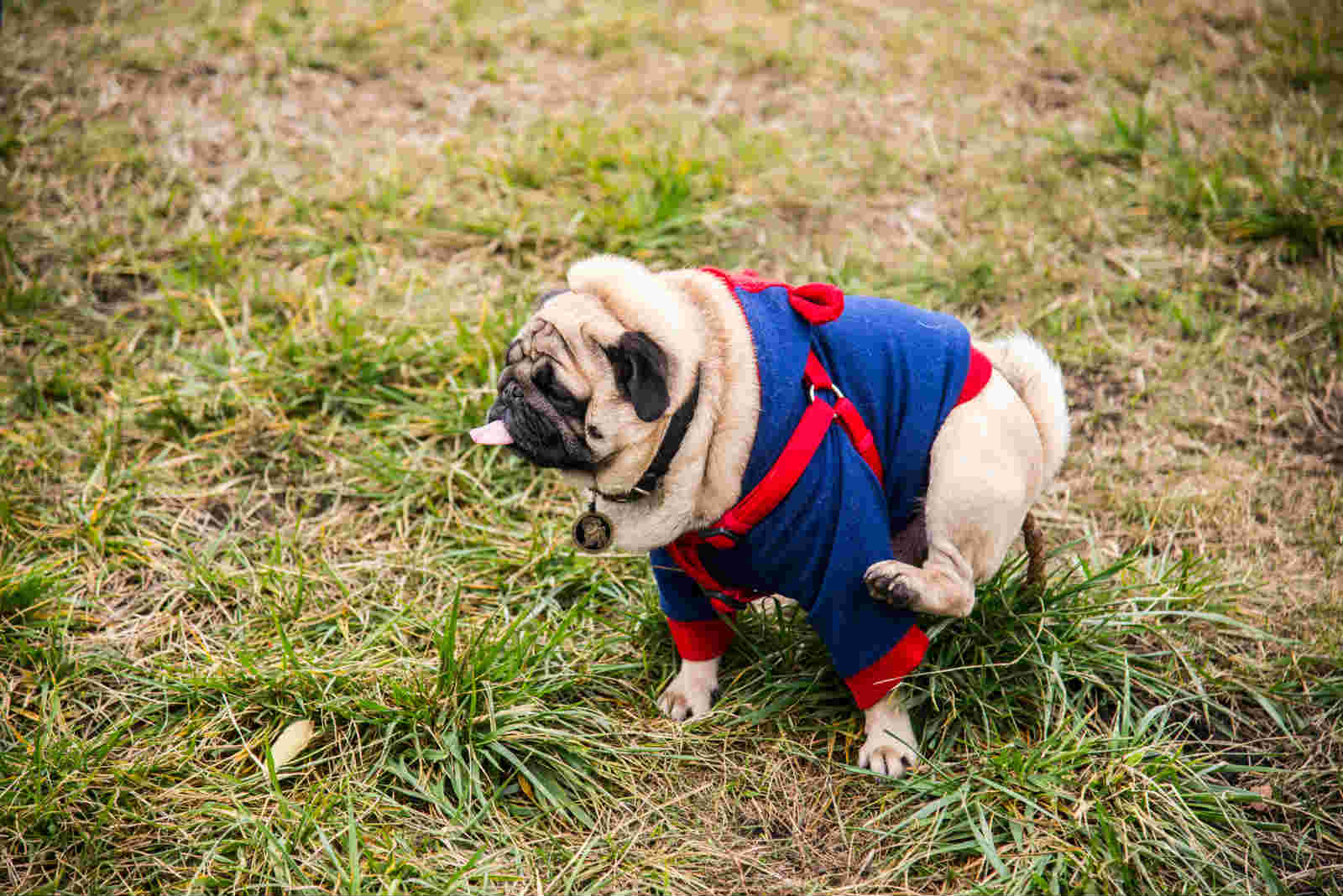When you get your pug puppy, all the feel-good feelings are probably all you could focus on at first. But once you both get into the swing of things, it’s time for training to start.
After all, you want your pug to have good manners—and you won’t want to clean up pee puddles forever.
Training your pug is unique since they’re unlike any other breed. Let’s learn just what works for pugs to make this process as painless for you both as possible.
Pug Training Philosophy
Every trainer may have their own method for pug training. The way you train your puppy helps bond the two of you together with trust and respect.
Sid was a challenging puppy to train. It felt like those days lasted forever. Every time I felt like we were making progress, we were back at square one. But before I knew it, my patience paid off, and he learned the ropes.
When you train your pug correctly, you develop your own way of communication with your dog. They should know to listen, but also that they’re protected. It goes deeper than basic commands—it is a part of their overall quality of life.
Pugs are sensitive, silly, and sometimes stubborn. The best method to teach your pug puppy is through positive reinforcement training. This type of training aims to reward good behavior without focusing so much on a negative correction.
So, even though you need to address the area that they might be lacking, you should always avoid harsh punishments and overkill corrections. Praise is so essential since it gives them the motivation to keep up the good work.
Are Pugs Easy to Train?
Pugs are definitely more challenging to train than a lot of other breeds. You can blame it on their short attention spans. But the good news is, pugs are typically very food motivated, so offering treats as an incentive can keep them alert.
Pugs are also small dogs, which means they have tiny bladders. They can’t hold their pee as long as larger breeds, so potty training needs to be in line with their needs. Sid had an incredibly hard time learning to hold it.
Pugs also have a stubborn streak. Sometimes, if they don’t want to do something, they just won’t do it. I can’t tell you how many times I’ve called Sid, just to have him stare at me totally unwilling to budge.
Don’t worry—not all pugs share this trait, and you can deal with it appropriately if they do. Ultimately, training a pug requires patience and consistency. If you stay on a routine and don’t slack, your pug puppy will eventually pick up on it.
Basic Obedience Training for Your Pugs
Basic obedience is teaching your pug puppy common commands like sit, stay, come, leave it. Pugs are incredibly food motivated, so always make sure to have snacks on hand.
Teach Your Pug to Sit
Teaching your pug to sit will give them good manners early on and also teach them self control.
- Hold up a tasty treat to get their attention.
- Hold your hand above their head, out of their reach—but close enough to smell.
- Hold the treat up higher than their head.
- Say the command, “sit.” (They won’t know at first—and that’s okay!)
- If your puppy doesn’t sit, place you’re hand gently on their lower back and push down while repeating, “sit.”
- When they sit, reward them with the treat.
Teach Your Pug to Stay
Teaching your pug to stay helps them learn self-control. They must listen since sometimes your pug can get ahead of themselves.
It’s natural for your dog to want to follow you, so this training is vital for the times when they just can’t come along.
- Command your puppy to sit while you’re standing up.
- Put your hand up, using a flat palm to signal, “stop.”
- Take a step away from them, saying, “stay.”
- If your pug obeys, reward them. If not, start the process over.
- Increase your distance, taking steps further away every time you command them to stay.
- You can increase gradually over time, so it’s not too much at once.
Teach Your Pug to Come
When you guide your pug to come to you, you can call them in for several reasons. If they learn to obey, you can protect them in times when they’ve gone a little too far or when it’s time to leave the dog park.
- Use their favorite treat for motivation.
- Hold out the snack for them to see, and say, “come.”
- When they come for the treat, reward them.
- Repeat this until they recognize the word without the treat.
- Eventually, you can stop offering a treat when you say the command, and you can call them to you without it.
Teach Your Pug to Leave It
Pugs have a particularly hard time learning to resist temptation. You’ll want to make sure you work on this one since it can be pretty tricky to master.
Sid still struggles with learning to leave something alone that he shouldn’t have by vocal commands only.
- Use their favorite treat in one hand and a less desirable snack in the other. For example, you can use a tasty piece of dehydrated or plainly cooked meat and something less appealing—like an apple slice.
- Have your puppy sit down in front of you and direct your attention toward them, so they keep focus.
- Let them smell the less desirable snack first. As they sniff, command them to “leave it.” Encourage your pug to back off.
- If your pug listens to your command—praise and reward them by offering up the tastiest treat.
Check this Youtube video training a Pug
How to Potty Train a Pug Puppy
Potty training may be one of the most challenging things you’ll teach your pug. It requires a lot of patience from you and a routine you have to follow to a fault. You should begin potty training as soon as you get your puppy to get used to the process.
Before you begin, you have to remember that these puppies have never learned where to use the bathroom, so this is entirely new to them.
Keep in mind that just because it’s a commonplace theme for you doesn’t mean it will be easy for them to learn.
-
Designate an Area for Potty Time
Having one area only that they use the bathroom will quickly help them identify where to go. Make this a small area away from any spot they romp or play to spot the difference.
-
Take Your Pug Out at Specific Times
Offering potty breaks helps your pug place potty time appropriately. Take them outside after playtime, meals, and sleep.
While they’re very small, they can only hold their bladder for a short time. Taking them outside to use the bathroom every hour will get them into a routine.
- Remember to Praise Your Pug for a Job Well-Done
Be patient while your pup sniffs around the area. Designate 5 to 10 minutes every trip out to wait for them to go.
Every time your buddy does their business, vocalize approval to them and show them affection by petting and offering treats.
- Leave the Potty Area Immediately After
Once they use the bathroom in their spot, take them back inside right away. Doing so will further instill the idea that this is a place to potty—and nothing else.
- Always keep your pug on a leash or harness
- Try not to give them any attention before they go potty
- Leave poop in the area at first so they can smell it and realize this is what the area is for
If Your Pug Doesn’t Go…
If your pug goes out but doesn’t use the bathroom, take them back inside for a few minutes (usually no more than 10 minutes.)
You can set a timer if that helps you remember. Take them back out when the timer goes off—or if you see them sniffing around the house for a place to go. Repeat the steps.
How to Crate Train a Pug Puppy
Crate training your puppy is an essential part of raising them. Teaching them to be in a crate helps when you have to leave the house or at bedtime. It’s also a handy tool while you’re potty training.
Pugs who stay in the crate between potty time are much less likely to go in the house. Dogs don’t like to use the bathroom where they lay or sleep. If you get an appropriately sized crate, it will work wonders for different life stages.
Many crates have dividers where you can separate the space, limiting the amount of room they have. That is really helpful, so you don’t have to buy multiple cages as they grow.
Once your pug is potty-trained and well-behaved, you won’t have to keep them in their crate as often. You can reserve crate stays if they need put up while you’re away or at night when you can’t supervise.
Pick a Suitable Crate
Pugs, luckily, don’t get very big. That means you can buy a small crate with a divider that you can use as they grow up. You want your pug to be in an area that is big enough to comfortably fit their body without giving them too much wiggle room.
Ultimately, you don’t want your pug to think they can use part of the crate as a bathroom spot. If the crate is too big, they may think they can doo-doo in the corner without consequence.
It’s also important to take off collars or other attachments while they’re in the crate since they can potentially choke while you’re away. Your puppy needs to be safe, comfortable, secure, and at home in their crate.
How to Begin Crate Training
When you’re ready to introduce your pug to their crate, start out slow and let them explore the space before leaving them for longer periods.
The more they acclimate themselves, the sooner they will adjust.
- Leave the crate open and let your pug sniff the cage or climb in and out.
- Use a word that you feel comfortable with and that your pug can recognize. You can use the term “crate”, or even “bed.” No matter what term you use, keep it consistent, so they learn to relate the word to their space.
- Spend roughly five to ten minutes getting your pug used to the crate.
- Let your pug inspect the inside. You can encourage them to get inside by offering their favorite toys or snacks.
- Once you feel that they have gotten used to the new object, try to close the door. You can offer a treat through the cage bars to show approval. Stay with your pug for a few minutes with the door shut. You can pet them through the cage, continuing to use your association word.
- If your puppy starts to act nervous or fidgety, open the crate to let them out. Give them a break for several minutes and then attempt to repeat the process.
- Each time you put them inside, you can shut the door a bit longer. Don’t overdo it. Watch your pug’s body language and always open the crate once it seems like they don’t feel comfortable.
- Once your pug gets used to the process, you can leave them alone in a room for a few minutes at a time. Each puppy will progress differently.
Crate Training Pointers
When you’re starting with crate training, you want to make sure your pug develops a healthy relationship with this process.
- Place the crate in your room or near you at night while you sleep, so they feel at ease
- Put their favorite blanket or a nice, comfy bed in their crate for ultimate comfort
- Drape a blanket over the crate to create a safe atmosphere
- Put a toy or two in the crate if they need something to chew on
- Reward your pup by giving them a treat when they enter or exit the crate
Overnight Crating
When your puppy is ready to sleep in their crate overnight, you should always make sure they are ready to avoid accidents.
A few things to make sure of:
- Make sure you have taken them out to potty one last time—and make sure they go
- Don’t put them into the crate if they are still overly wound up
- Make sure there isn’t a lot of noise or chaos around them when bedtime comes
- It’s best to put them in their crate when you are also ready to sleep
- It’s also a good idea to tucker them out really well beforehand, so they are ready for sleep
- Don’t feed or water your puppy for approximately two hours before locking them up
If your puppy is whining or crying, find the cause. It could be that they need to go outside and they are trying to tell you. It may just be for attention. If you know they just went to the bathroom, try not to give in to their pleas.
If they know they can get their way by making a fuss, this can develop into bad behavior. So, the best thing to do with attention cries is to ignore them no matter how hard it might be.
How to Leash Train a Pug Puppy
When it comes to walking on a leash, Sid was very good at this. We used a harness for him since pugs are brachycephalic dogs.
That means they have flattened muzzles, which can cause breathing problems. Attaching a leash to a collar is dangerous—and can even be deadly—for this breed.
Always, always, always use a harness for leash training! I can’t stress this enough.
Leash training is so important when you own a dog. Once they are mannerly on a leash, you can take them virtually anywhere without them trying to pull or veer off in other directions. You can start very early—as soon as you bring them home.
The earlier you introduce them to a leash, the more second nature it will become. Initially, it may feel awkward for them, but no worries—they will adjust soon enough.
Your pug may bite at the leash or try to squirm away from it at first. After all, it’s totally new and not something they’ve ever done before. Have patience. I promise it gets easier.
Introducing Your Pug Puppy to a Leash and Harness
To get them comfortable with this process, you’ll have to start slow as every training aspect requires.
- Let them use their sniffer. First, place the harness on the ground for them to check out. They can nudge and smell it, but make sure you don’t let them chew it since they may think it’s okay to do in the future.
- Pick up the harness to show them, letting your puppy know you think it’s the bee’s knees. Touch the harness to their body to gauge a reaction.
- Put the harness on them. This part may be a bit of a struggle since they may wonder what the heck is going on. You can reassure them with a toy or treat.
- Now it’s time for the leash. Repeat the process with the sniffing introduction. Once they check it out, you can attach it to the D-ring of the harness.
- Again, if your puppy is biting at the leash or trying to back out of it (which is totally normal), reassure them with a treat or toy.
- Stand up and walk backward, calling your puppy to come toward you.
- Reward them with another treat to show that you approve. You will probably only have to go through this lengthy process a few times before they aren’t scared of it anymore.
After Your Pug Puppy Accepts the Leash
You should use the harness and leash on bathroom breaks, anytime you’re out of the house, and maybe sometimes around the house—just for good measure.
The more you walk them with a leash, the better they will do.
If your pug starts to pull or get very frisky while you’re walking them, you can work on leash manners.
Since your pug is a small dog, they shouldn’t be too hard to control, and you shouldn’t have a huge issue with the process.
The more you use the leash and the more experiences they have, the better behaved they will be. If you start as soon as you get your pug, they will accept it as a natural part of their daily life.
Sid was used to the harness and leash after about two weeks of using it, and we’ve had no issues since.
When to Start Training a Pug Puppy
It’s never too early to start training your pug after you bring them home.
We started Sid right away at only eight weeks old. Training before six months of age is the best way to get fast results.
Ultimately, the earlier, the better. A good age to start with training is roughly nine weeks—only a week after you bring them home.
Forming early habits will help them become acclimated before they have a chance to form poor behaviors.
Last Thoughts on Pug Training
Every pug is different and will learn at their own pace. Training Pugs can be somewhat taxing at first—and that’s okay—you’re both learning together.
Remember, you’re the leader, so just show patience, love, and understanding even when you’re frustrated.
The calmer and more consistent you stay, the faster they will learn the routine. You’ll have a well-behaved, mannerly pug in no time!


